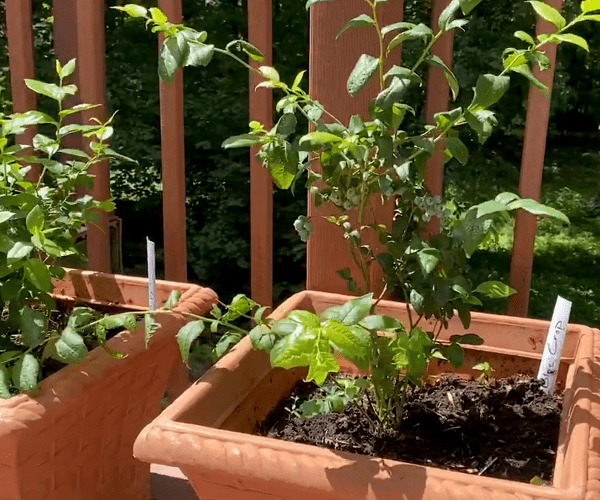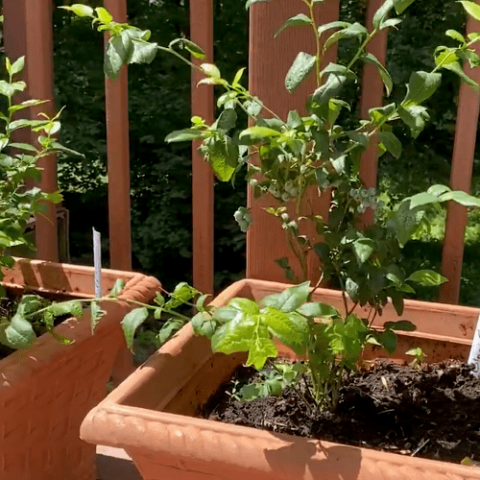Growing blueberries in large pots is a perfect way to grow some of your own food at home when you are constrained by not having a large garden area, or if your garden area is shady (blueberries like full sun).
This summary will give you the basic requirements for success, with a how-to video included at the end of the post.

Jump to: Size of Pot | Best Varieties for Pots | Growing Requirements | Wintering Over
This post may contain affiliate links (at no cost to you). Here’s our disclosure information
Benefits of Growing Blueberries in Pots
There are actually a number of benefits to growing blueberries in pots, to include:
- you can quickly move them if a hailstorm or severe weather is imminent
- the deer and rabbits will not eat them if they are on a deck or balcony
- they are easy to transplant outside if your garden location changes
- it is easier to keep them free of weeds and grass
- it is easier to prevent bird damage if the pots are close to your house
Keys to Growing & Harvesting Blueberries
One decision you need to make if you grow blueberries in pots (or in the garden) is whether to share them with the birds or try to prevent bird damage and keep them for yourself.
Birds are voracious with blueberries and they will get them right before they ripen, leaving you with a sad crop.
If you grow blueberries close to your house on a deck or a balcony, you might be able to harvest before the birds get them.
If not, you will need to to protect plants from the birds with bird netting raised over the plants (*note: bird netting is very sticky and it doesn’t work to just toss it over the plants as you will pull off the berries and leaves when removing it to harvest).
As a blueberry farmer I grow my plants in the field, but each plant has a special 3-foot hole that is all their own in terms of soil. The same principles around soil can be applied when growing blueberries in pots (see below tips for container size).

What size of Container or Pot?
In the field, most varieties of “low bush” or “half high” blueberries grow to a width of around 3 feet and a height of 2 to 4 feet.
A “highbush” blueberry will grow 7 to 8 feet tall with a 4 to 6 foot spread . The width is considered the drip line.
Blueberries have fairly shallow roots so while a fairly wide pot is required, it does not have to be extremely deep. Consider the drip line and get a wide container (at least 20″) for the roots to spread out. The height of the pot should be around 24 inches.
**Tip: Blueberries are really pretty in pots, but even more so when given a frill of something else beneath. Try underplanting them with some violet-flowered wood violets to amplify the beauty even more.
With respect to climate, for zone 4 and colder, you would be best served by one of the low bush or half-high varieties.
My favorite nursery for ordering blueberry plants is De Grandchamps Farm in Michigan. I have been growing plants from them for many years now (600 plants to be specific) and they are the best, offering healthy plants and information on the best for your zone.
When you grow blueberries in pots, you can be a bit more flexible in varieties since you can easily move them, protect them from deer, and move them inside in the winter.
While you could grow high bush blueberries in pots, consider their height (7 to 8 feet) and spread (3-5 feet) at maturity and decide if you really want to grow in a huge pot. You can get a very good harvest with half high varieties grown in pots.
Some of the popular half high varieties that grow well in pots include North Blue, Polaris, Chippewa and Northland.
Lastly, you will get many more berries if you grow two different varieties (even if one says it is self pollinated). The bees will cross-pollinate the plants and result in a far larger harvest.
I like to get an early variety (Polaris), a mid-season variety (Northland) and a late variety (Chippewa) to extend the harvest as long as possible.

Note: In Minnesota, the blueberry harvest typically begins in mid-July and extends to mid-to-late August (with the right varieties)
Requirements to Successfully Grow Blueberries in Pots
SUN:
As with most berries and vegetables, full sun is required for a good harvest. If you grow blueberries in shady locations, they will survive but there won’t be much fruit.
Full sun is considered to be 6 hours of sun per day. Blueberries can withstand much more sun than that, but 6 hours is probably the minimum
SOIL:
There are two primary considerations when it comes to soil; acidity and drainage. Blueberries prefer an acid soil, but they also like a well-drained soil that is rich in nutrients.
Sand is well drained, but the nutrients and minerals leech out of it quickly. Clay will hold water too long and blueberries do not like to have wet feet for long.
When growing in the field, the best combination I have found is to dig a 3-foot hole and within that hole mix in 1/3 peat (for acid), 1/3 compost (for drainage), and 1/3 of your garden soil for the micronutrients.
When growing in pots, I recommend 1/2 peat and 1/2 good (but sterile) potting soil. Mix it together very, very thoroughly as water will wick off peat and not get to the roots if it is just layered into the pot.
Mulch the top of the pot with some pine needles, or wood chips to conserve soil moisture

The peat will be enough acid for the first year. After that fertilize with a fertilizer made for blueberry plants (available in all nurseries).
At some point your potted plant will benefit from repotting (every year is good). Just make sure and repot and refresh the soil before the plant is flowering to avoid transplant shock.
For keeping them acidic over time, scratch in a little elemental sulfur around the drip-line in the Fall. It will be slowly incorporated and help keep the soil acidic.
This is an organic way to help with acidity. Miracid works also, but is not organic.
Avoid the temptation to over-fertilize, as it can burn their shallow roots.
VARIETY:
Do some research to select the best variety for your climate and growing conditions. Your local extension service is a good place to ask these questions.
Also, even if the nursery tells you that you don’t need two different varieties in order to get berries, just know that growing at least two different varieties will result in MORE berries. The bees love to cross pollinate. The more varieties you have the better.
Pro Tip: It also helps to extend the season if you select an early variety, a mid-season variety and a late variety.
How Long Before Blueberry Plants Produce Fruit
Blueberry bushes are considered mature when they reach 5 years old. You should get a couple handfuls of berries the first year (after planting a 2-year old plant), and it will increase each year thereafter.
Blueberries are considered mature at 5 years of age. Upon maturity an average harvest is around 5 pints per plant (depending on variety and growing conditions)

How Long Do They Live?
Blueberries are long-lived plants. In the ground they can live for up to 30 years (mine are 28 years old). They are also long-lived in pots. I have had 5 varieties in pots for 8 years now.
They are woody plants and it will help to remove the old really woody canes as they mature, as that will encourage new fruiting canes that sprout from the roots. Do this before they bloom however, as bees need to pollinate the blooms in order to get fruit.
Wintering Over Plants in Pots
Winter cold can be the limiting factor when growing blueberries in containers. They do not like having their root systems completely frozen and that is likely when grown above ground in a cold climate.
There are tested ways to protect your potted blueberry plants in cold Winter climates, from burying them in the ground, to keeping them in a cool garage with some precautions.
It is critical to have good drainage to avoid ice building up in them during freezing winter weather. Make sure and drill holes in your containers.
You can also move them into an unheated garage in late fall. You will need to water them periodically over the winter, maybe two or three times.
They do not like drying out completely, as they lack root hairs. Root hairs are what helps most plant roots absorb water and nutrients. Without the root hairs, blueberries are very sensitive to too much or too little water.
This article on how to overwinter potted plants is more detailed and covers overwintering potted plants in general, rather than just blueberries.
Alternatively, if you want to see a visual tutorial on growing in pots, click on the video below.
If you like my articles about cooking and gardening, subscribe to my weekly newsletter, where I share free recipes and gardening tutorials.


This is great information. Thank you for sharing!